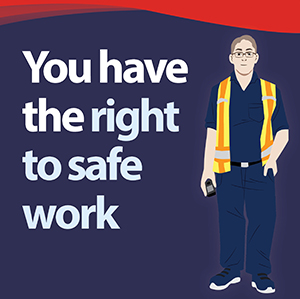Workplace Safety & Health

On any given day, MGEU members can face a variety of hazards on the job, including:
- excessive noise;
- poor ergonomics;
- violence;
- exposure to chemicals;
- biological hazards;
- unrealistic work quotas;
- poor work organization or shift scheduling; and
- insufficient training or supervision.
The Provincial Workplace Safety and Health Act is written to protect workers from hazards while on the job.
The Act sets out duties for all employers and workers, and identifies a worker’s rights when faced with unsafe work. It also establishes procedures for dealing with workplace hazards, and provides for enforcement when the law is not complied with.
Know your Workplace Safety and Health rights
The Right to Know…
- You have the right to know about any hazards you may encounter in your workplace, and how to protect yourself from them.
- You should receive safety and health training and instruction before you begin work, and when your work changes.
- You should be under the direction of a competent supervisor who can show you how to perform your work safely.
The Right to Participate…
- You have the right to participate in a workplace Safety and Health Committee if there are 20 or more employees in your workplace.
- You have the right to have a Worker Safety and Health Representative if there are between 5 and 19 employees in your workplace.
- You have the right to ask for additional information or voice a concern related to safety and health hazards to which you may be exposed.
The Right to Refuse Unsafe Work…
- You have the right to refuse work that you believe is dangerous to your safety and health or to others.
The Right to Protection
- If you exercise a right or carry out a duty under the Workplace Safety and Health Act or Regulations, you cannot be disciplined or discriminated against.
- This includes using your right to refuse unsafe work, or reporting a safety and health concern to your supervisor, a Safety Committee member, the Worker Safety Representative, your Union or Workplace Safety and Health.
How to address ongoing safety and health concerns in your workplace
MGEU Safety and Health staff and activists provide consultation and training to help workplaces implement practices to keep workers safe and encourage member participation. Joint union/management Workplace Safety and Health Committees are the union's best opportunity to actively identify and address ongoing concerns.
Want to get involved as a workplace safety and health representative? Not sure if there’s a safety and health committee in your workplace? Contact us and we’ll help you find out.
How to file a WCB claim when injured on the job
If you’re injured on the job, you must file a Workers Compensation claim as soon as possible. Visit www.wcb.mb.ca/how-to-file-a-claim-workers to follow the steps on how to file your claim. If you need help from your union during this process or have a general question about WCB claims, feel free to contact us.
How to report unsafe work
Contact Workplace Safety and Health to report unsafe work.
How to refuse unsafe work
Under Manitoba law, (The Workplace Safety and Health Act), you have the right to refuse work for anything that you reasonably believe is a danger to your safety and health or the safety and health of others. This could be something you believe will cause immediate and serious, or long-term effects on your safety and health. The Workplace Safety and Health Act Section 43 outlines the procedure that must be followed, and this process should be understood before a refusal is initiated.
Step 1 – Report the dangerous condition
Report immediately to your employer, supervisor, or to any other person in charge at the workplace, giving your reasons for refusing to work. If the matter is solved to your satisfaction, go back to work. If the employer does not correct the dangerous condition, go to Step 2.
Step 2 – Involve the safety and health committee, representative or another worker
If the employer does not correct the dangerous condition immediately, the person who received the report of refusal to work (or a person designated by them) must inspect the dangerous condition in the presence of the refusing worker and one of the following persons:
- If there is a safety and health committee in the workplace, the worker co-chair, or if they are unavailable, a committee member who represents workers;
- The workplace safety and health representative; or
- If there is no safety and health committee member or representative available, another worker selected by the worker who is refusing to work.
If this inspection results in the matter being solved to your satisfaction, go back to work. If the dangerous condition is still not remedied, go to Step 3.
Step 3 – Contact the Workplace Safety and Health Branch
If, after the inspection in Step 2, the dangerous condition has not been removed, any of the persons present during the inspection may notify the Workplace Safety and Health Branch by calling 204-957-SAFE (7233) in Winnipeg or 1-855-957-SAFE (7233) outside of Winnipeg. The notification of the right to refuse is given high priority within the branch to resolve (a safety and health officer is available 24 hours a day, 7 days a week to respond to emergencies). A safety and health officer will investigate the matter promptly and decide whether the job situation or task the worker has refused is dangerous to the safety or health of the worker or any other worker or person at the workplace.
If the officer decides that the job situation or task the worker has refused is dangerous to the safety or health of the worker or any other worker or person at the workplace, they will provide the refusing worker, each committee co-chairperson, or the representative, and the employer with a written report stating their findings. They will also issue improvement orders or stop work orders to the employer as necessary to correct the dangerous condition.
If the officer decides that the work being refused is not dangerous, they will inform the employer and the refusing worker of that decision in writing, and inform the worker that he or she is no longer entitled to refuse the work.
For more information about the right to refuse unsafe work, download the Safe Work Bulletin.
Where to learn more about Manitoba Workplace Safety and Health
Through SAFE Work Manitoba, the Workplace Safety and Health branch and the Workers Compensation Board work together with partners to prevent workplace injuries and illnesses through promotion, protection, and education.
Frequently Asked Questions - Workplace Safety & Health
What is the Internal Responsibility System (IRS)?
The internal responsibility system is the underlying philosophy of safety and health legislation. All parties in the workplace – both employees and employers – are responsible for safety and health.
The Internal Responsibility System:
- Establishes responsibility sharing systems
- Promotes safety culture
- Promotes best practice
- Helps develop self reliance
- Ensures compliance
What is the responsibility of the Employer?
The employer’s principal duties under the Workplace Safety and Health Act and Regulations is to comply with legislative requirements. This is a duty to prioritize the safety and health of workers.
Section 4 under the Act assigns duties to employers and provides for other duties to be prescribed by regulation. Some of the general duties require an employer to:
- Take all reasonable precautions to protect the health and safety of workers;
- Ensure that equipment, materials and protective equipment are maintained in good condition;
- Provide information, instruction and supervision to protect worker health and safety; and
- Co-operate with the JHSC.
What are the duties of Supervisors?
The employer must ensure that all of the employer's workers are supervised by a person who
- is competent, because of knowledge, training or experience, to ensure that work is performed in a safe manner, and
- is familiar with this Act and the regulations that apply to the work performed at the workplace;
Every supervisor shall...
- so far as is reasonably practicable,
- take all precautions necessary to protect the safety and health of a worker under his or her supervision,
- ensure that a worker under his or her supervision works in the manner and in accordance with the procedures and measures required by this Act and the regulations, and
- ensure that a worker under his or her supervision uses all devices and wears all clothing and personal protective equipment designated or provided by the employer or required to be used or worn by this Act or the regulations;
- advise a worker under his or her supervision of all known or reasonably foreseeable risks to safety and health in the area where the worker is performing work;
- co-operate with any other person exercising a duty imposed by this Act or the regulations; and
- comply with this Act and the regulation
Do workers have duties under the WSH Act?
Workers have a general duty to take responsibility for safety and health of themselves or others. Section 5 of the Workplace Safety and Health Act lists additional specific duties:
- Work in compliance with the Act and regulations;
- Use any equipment, protective devices or clothing required by the employer;
- Tell the employer or supervisor about any known missing or defective equipment or protective device that may be dangerous;
- Report any known workplace hazard or violation of the Act to the employer or supervisor
When does a workplace have to establish a Workplace Safety and Health Committee or Representative?
A Safety and Health Committee is a committee of at least 4 (maximum 12) persons, who represent the workers and the employer at a workplace. Their primary role is to identify workplace health and safety concerns and bring them to the attention of the employer. Section 40 of the Workplace Safety and Health Act requires a Safety and Health Committee to be established at any workplace that regularly (for a period of 90 days or longer) employs 20 or more workers.
Each employer shall cause a worker not associated with management to be designated as the worker safety and health representative at a workplace, other than a construction project, where a safety and health committee is not required but where five or more (5-19) workers are regularly employed.
How does a workplace establish membership to a Workplace Safety and Health Committee or Representative?
Workplace Safety and Health Committee members must be appointed in accordance with the constitution of the union that is the certified bargaining agent or that has acquired bargaining rights on behalf of those workers. The MGEU constitution states “A Local Executive Committee may elect or appoint Workplace Safety and Health Committee member(s) or a Workplace Safety and Health representative. These members will be elected or appointed from the Local membership.”
What are the functions of the Workplace Safety and Health Committee or Representative
The primary responsibility is to help maintain a safe and healthy workplace by discussing concerns, making recommendations, and following-up on progress made. Committees and Representatives also have a responsibility to be involved in workplace inspections, investigations of safety and health concerns, and the right to refuse process.
What are the “Terms of Reference” required by the Workplace Safety and Health Regulation?
Manitoba’s Workplace Safety and Health Regulation Part 3.6 requires that a committee establish written rules of procedure for establishing the date, time and place for meetings as well as other rules respecting the conduct of committee meetings.
